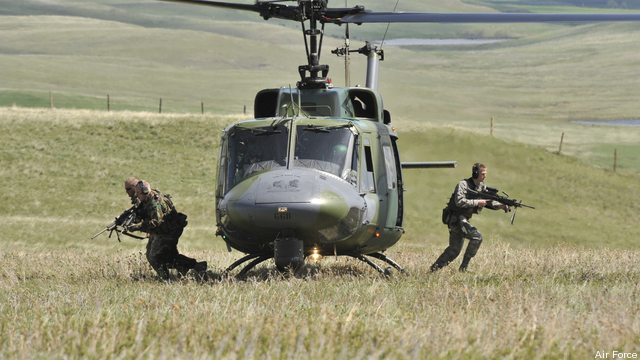HH-60U Lockheed Martin replacement for UH-N1
CORRECTED: Passenger Capacity WASHINGTON: The day before the Air Force Association’s annual winter conference begins, the newest wrinkle in the years-long saga of deciding what aircraft the Air Force would buy to secure America’s nuclear missile fields was announced. Lockheed Martin’s Sikorsky will offer — surprise! — an updated version of the Black Hawk helicopter, the HH-60U.
Last May, the Air Force dropped its plan to just pay $1.4 billion in a sole-source deal to buy the upgraded Black Hawks to replace the aging UH-N1s now in its fleet. Air Force Global Strike Command has said the Hueys are too slow and lack the necessary range to handle the critical nuclear security mission.
The helicopters are used at all three missile bases, Malmstrom, Minot and Warren AFBs.

Air Force UH-1N helicopter during an emergency drill.
A key requirement for the competitors to meet is the ability to carry a full load of nine combat-ready airmen. Lockheed says their HH-60U can carry indeed transport nine fully outfitted Security Forces specialists, special equipment and two special mission aviators for the Continuity of Operations mission, which is all about getting senior leaders out of harm’s way in a disaster or attack. Lockheed says that mission requires transport for eight. The company also says the HH-60U can carry 9,600 pounds “of useful load.”
The continuity mission is in addition to keeping the missile fields secure and responding to any threats to them or to their nuclear payloads.
Lockheed noted in its release that the HH-60U “shares 85 percent commonality with the service’s incoming fleet of HH-60W Combat Rescue Helicopters, and it will share the existing infrastructure that supports the Air Force’s retiring fleet of HH-60G Pave Hawks.” There are already three HH-60U Black Hawk aircraft in the Air Force’s inventory.
Finnemeccanica’s subsidiary Leonardo (formerly AgustaWestland) pressed hard last year for the Air Force to open the competition to a traditional competitive acquisition. It wanted to offer its American-assembled AW139.
Corrected Wednesday 11:30 am. The original version of this article mistakenly stated the requirement was to carry eight troops; it is in fact nine.
Taking aim: Army leaders ponder mix of precision munitions vs conventional
Three four-star US Army generals this week weighed in with their opinions about finding the right balance between conventional and high-tech munitions – but the answers aren’t easy.



























